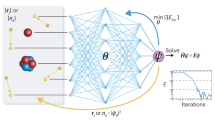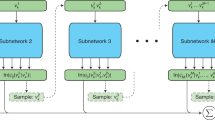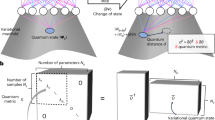Abstract
Quantum many-body methods provide a systematic route to computing electronic properties of molecules and materials, but high computational costs restrict their use in large-scale applications. Owing to the complexity in many-electron wavefunctions, machine learning models capable of capturing fundamental many-body physics remain limited. Here we present a deep learning framework targeting the many-body Green’s function, which unifies predictions of electronic properties in ground and excited states, while offering physical insights into many-electron correlation effects. By learning the many-body perturbation theory or coupled-cluster self-energy from mean-field features, our graph neural network achieves competitive performance in predicting one- and two-particle excitations and quantities derivable from a one-particle density matrix. We demonstrate its high data efficiency and good transferability across chemical species, system sizes, molecular conformations and correlation strengths in bond breaking, through multiple molecular and nanomaterial benchmarks. This work opens up opportunities for utilizing machine learning to solve many-electron problems.
This is a preview of subscription content, access via your institution
Access options
Access Nature and 54 other Nature Portfolio journals
Get Nature+, our best-value online-access subscription
27,99 € / 30 days
cancel any time
Subscribe to this journal
Receive 12 digital issues and online access to articles
99,00 € per year
only 8,25 € per issue
Buy this article
- Purchase on SpringerLink
- Instant access to full article PDF
Prices may be subject to local taxes which are calculated during checkout





Similar content being viewed by others
Data availability
Source data are provided with this paper. The datasets used in this work are available via Zenodo at https://doi.org/10.5281/zenodo.15131927 (ref. 72).
Code availability
The code used in this work is available via Zenodo at https://doi.org/10.5281/zenodo.15175905 (ref. 73) and via GitHub at https://github.com/ZhuGroup-Yale/mlgf. Its implementation uses the fcDMFT code available at https://github.com/ZhuGroup-Yale/fcdmft and PySCF at https://github.com/pyscf/pyscf.
References
Kohn, W. & Sham, L. J. Self-consistent equations including exchange and correlation effects. Phys. Rev. 140, A1133 (1965).
Cohen, A. J., Mori-Sánchez, P. & Yang, W. Challenges for density functional theory. Chem. Rev. 112, 289 (2012).
Bartlett, R. J. & Musiał, M. Coupled-cluster theory in quantum chemistry. Rev. Mod. Phys. 79, 291 (2007).
Hybertsen, M. S. & Louie, S. G. Electron correlation in semiconductors and insulators: band gaps and quasiparticle energies. Phys. Rev. B 34, 5390 (1986).
Golze, D., Dvorak, M. & Rinke, P. The GW compendium: a practical guide to theoretical photoemission spectroscopy. Front. Chem. 7, 377 (2019).
Keith, J. A. et al. Combining machine learning and computational chemistry for predictive insights into chemical systems. Chem. Rev. 121, 9816 (2021).
Westermayr, J. & Marquetand, P. Machine learning for electronically excited states of molecules. Chem. Rev. 121, 9873 (2021).
Deringer, V. L. et al. Gaussian process regression for materials and molecules. Chem. Rev. 121, 10073 (2021).
von Lilienfeld, O. A., Müller, K. R. & Tkatchenko, A. Exploring chemical compound space with quantum-based machine learning. Nat. Rev. Chem. 4, 347–358 (2020).
Behler, J. & Parrinello, M. Generalized neural-network representation of high-dimensional potential-energy surfaces. Phys. Rev. Lett. 98, 146401 (2007).
Zhang, L., Han, J., Wang, H., Car, R. & Weinan, E. Deep potential molecular dynamics: a scalable model with the accuracy of quantum mechanics. Phys. Rev. Lett. 120, 143001 (2018).
Schütt, K. T., Sauceda, H. E., Kindermans, P. J., Tkatchenko, A. & Müller, K. R. SchNet—a deep learning architecture for molecules and materials. J. Chem. Phys. 148, 241722 (2018).
Smith, J. S. et al. Approaching coupled cluster accuracy with a general-purpose neural network potential through transfer learning. Nat. Commun. 10, 2903 (2019).
Qiao, Z., Welborn, M., Anandkumar, A., Manby, F. R. & Miller, T. F. OrbNet: deep learning for quantum chemistry using symmetry-adapted atomic-orbital features. J. Chem. Phys. 153, 124111 (2020).
Schütt, K. T., Gastegger, M., Tkatchenko, A., Müller, K. R. & Maurer, R. J. Unifying machine learning and quantum chemistry with a deep neural network for molecular wavefunctions. Nat. Commun. 10, 5024 (2019).
Westermayr, J. & Maurer, R. J. Physically inspired deep learning of molecular excitations and photoemission spectra. Chem. Sci. 12, 10755 (2021).
Li, H. et al. Deep-learning density functional theory Hamiltonian for efficient ab initio electronic-structure calculation. Nat. Comput. Sci. 2, 367–377 (2022).
Gong, X. et al. General framework for E(3)-equivariant neural network representation of density functional theory Hamiltonian. Nat. Commun. 14, 2848 (2023).
Grisafi, A. et al. Transferable machine-learning model of the electron density. ACS Cent. Sci. 5, 57 (2019).
Brockherde, F. et al. Bypassing the Kohn–Sham equations with machine learning. Nat. Commun. 8, 872 (2017).
Li, C., Sharir, O., Yuan, S. & Chan, G. K.-L. Image super-resolution inspired electron density prediction. Preprint at http://arxiv.org/abs/2402.12335 (2024).
Knøsgaard, N. R. & Thygesen, K. S. Representing individual electronic states for machine learning GW band structures of 2D materials. Nat. Commun. 13, 468 (2022).
Hou, B., Wu, J. & Qiu, D. Y. Unsupervised representation learning of Kohn–Sham states and consequences for downstream predictions of many-body effects. Nat. Commun. 15, 9481 (2024).
Shao, X., Paetow, L., Tuckerman, M. E. & Pavanello, M. Machine learning electronic structure methods based on the one-electron reduced density matrix. Nat. Commun. 14, 6281 (2023).
Bai, Y., Vogt-Maranto, L., Tuckerman, M. E. & Glover, W. J. Machine learning the Hohenberg–Kohn map for molecular excited states. Nat. Commun. 13, 7044 (2022).
Hedin, L. New method for calculating the one-particle Green’s function with application to the electron-gas problem. Phys. Rev. 139, A796–A823 (1965).
Blase, X., Duchemin, I., Jacquemin, D. & Loos, P.-F. The Bethe–Salpeter equation formalism: from physics to chemistry. J. Phys. Chem. Lett. 11, 7371 (2020).
Zhu, T. & Chan, G. K. L. All-electron Gaussian-based G0W0 for valence and core excitation energies of periodic systems. J. Chem. Theory Comput. 17, 741 (2021).
Lei, J. & Zhu, T. Gaussian-based quasiparticle self-consistent GW for periodic systems. J. Chem. Phys. 157, 214114 (2022).
Nooijen, M. & Snijders, J. G. Coupled cluster Green’s function method: working equations and applications. Int. J. Quantum Chem. 48, 15 (1993).
Peng, B. & Kowalski, K. Green’s function coupled-cluster approach: simulating photoelectron spectra for realistic molecular systems. J. Chem. Theory Comput. 14, 4335 (2018).
Zhu, T., Jiménez-Hoyos, C. A., McClain, J., Berkelbach, T. C. & Chan, G. K.-L. Coupled-cluster impurity solvers for dynamical mean-field theory. Phys. Rev. B 100, 115154 (2019).
Laughon, K., Yu, J. M. & Zhu, T. Periodic coupled-cluster Green’s function for photoemission spectra of realistic solids. J. Phys. Chem. Lett. 13, 9122 (2022).
Phillips, J. J. & Zgid, D. Communication: the description of strong correlation within self-consistent Green’s function second-order perturbation theory. J. Chem. Phys. 140, 241101 (2014).
Hirata, S., Hermes, M. R., Simons, J. & Ortiz, J. V. General-order many-body Green’s function method. J. Chem. Theory Comput. 11, 1595 (2015).
Banerjee, S. & Sokolov, A. Y. Algebraic diagrammatic construction theory for simulating charged excited states and photoelectron spectra. J. Chem. Theory Comput. 19, 3053 (2023).
Ronca, E., Li, Z., Jimenez-Hoyos, C. A. & Chan, G. K. L. Time-step targeting time-dependent and dynamical density matrix renormalization group algorithms with ab initio Hamiltonians. J. Chem. Theory Comput. 13, 5560 (2017).
Gull, E. et al. Continuous-time Monte Carlo methods for quantum impurity models. Rev. Mod. Phys. 83, 349 (2011).
Kotliar, G. et al. Electronic structure calculations with dynamical mean-field theory. Rev. Mod. Phys. 78, 865 (2006).
Zhu, T., Cui, Z.-H. & Chan, G. K.-L. Efficient formulation of ab initio quantum embedding in periodic systems: dynamical mean-field theory. J. Chem. Theory Comput. 16, 141 (2020).
Zhu, T. & Chan, G. K.-L. Ab initio full cell GW+DMFT for correlated materials. Phys. Rev. X 11, 021006 (2021).
Lan, T. N., Kananenka, A. A. & Zgid, D. Communication: towards ab initio self-energy embedding theory in quantum chemistry. J. Chem. Phys. 143, 241102 (2015).
Venturella, C., Hillenbrand, C., Li, J. & Zhu, T. Machine learning many-body Green’s functions for molecular excitation spectra. J. Chem. Theory Comput. 20, 143 (2024).
Arsenault, L. F., Lopez-Bezanilla, A., Von Lilienfeld, O. A. & Millis, A. J. Machine learning for many-body physics: the case of the Anderson impurity model. Phys. Rev. B 90, 155136 (2014).
Dong, X., Gull, E. & Wang, L. Equivariant neural network for Green’s functions of molecules and materials. Phys. Rev. B 109, 075112 (2024).
Batzner, S. et al. E(3)-equivariant graph neural networks for data-efficient and accurate interatomic potentials. Nat. Commun. 13, 2453 (2022).
Reiser, P. et al. Graph neural networks for materials science and chemistry. Commun. Mater. 3, 93 (2022).
Knizia, G. Intrinsic atomic orbitals: an unbiased bridge between quantum theory and chemical concepts. J. Chem. Theory Comput. 9, 4834 (2013).
Qiao, Z. et al. Informing geometric deep learning with electronic interactions to accelerate quantum chemistry. Proc. Natl Acad. Sci. USA 119, e2205221119 (2022).
Wilhelm, J., Seewald, P. & Golze, D. Low-scaling gw with benchmark accuracy and application to phosphorene nanosheets. J. Chem. Theory Comput. 17, 1662 (2021).
Rupp, M., Tkatchenko, A., Müller, K. R. & Von Lilienfeld, O. A. Fast and accurate modeling of molecular atomization energies with machine learning. Phys. Rev. Lett. 108, 058301 (2012).
Ramakrishnan, R., Dral, P. O., Rupp, M. & Von Lilienfeld, O. A. Quantum chemistry structures and properties of 134 kilo molecules. Sci. Data 1, 140022 (2014).
Dunning, T. H. Gaussian basis sets for use in correlated molecular calculations. I. The atoms boron through neon and hydrogen. J. Chem. Phys. 90, 1007 (1989).
Woon, D. E. & Dunning, T. H. Gaussian basis sets for use in correlated molecular calculations. III. The atoms aluminum through argon. J. Chem. Phys. 98, 1358 (1993).
Sun, Q. et al. Recent developments in the PySCF program package. J. Chem. Phys. 153, 024109 (2020).
Adamo, C. & Barone, V. Toward reliable density functional methods without adjustable parameters: the PBE0 model. J. Chem. Phys. 110, 6158 (1999).
Fediai, A., Reiser, P., Peña, J. E. O., Wenzel, W. & Friederich, P. Interpretable delta-learning of GW quasiparticle energies from GGA-DFT. Mach. Learn. Sci. Technol. 4, 035045 (2023).
Zauchner, M. G., Horsfield, A. & Lischner, J. Accelerating GW calculations through machine-learned dielectric matrices. npj Comput. Mater. 9, 184 (2023).
Gao, W., Tang, Z., Zhao, J. & Chelikowsky, J. R. Efficient full-frequency GW calculations using a Lanczos method. Phys. Rev. Lett. 132, 126402 (2024).
Kühne, T. D. et al. CP2K: an electronic structure and molecular dynamics software package—Quickstep: efficient and accurate electronic structure calculations. J. Chem. Phys. 152, 194103 (2020).
Zhu, T., Peng, L., Zhai, H., Cui, Z.-H. & Chan, G. K.-L. Towards an exact electronic quantum many-body treatment of Kondo correlation in magnetic impurities. Preprint at http://arxiv.org/abs/2405.18709 (2024).
Taube, A. G. & Bartlett, R. J. Frozen natural orbital coupled-cluster theory: forces and application to decomposition of nitroethane. J. Chem. Phys. 128, 164101 (2008).
Li, J. & Zhu, T. Interacting-bath dynamical embedding for capturing non-local electron correlation in solids. Phys. Rev. Lett. 133, 216402 (2024).
Cui, Z.-H., Zhu, T. & Chan, G. K.-L. Efficient implementation of ab initio quantum embedding in periodic systems: density matrix embedding theory. J. Chem. Theory Comput. 16, 119 (2019).
Paszke, A. et al. Automatic differentiation in PyTorch. In Proc. 31st Conference on Neural Information Processing Systems (NIPS), Workshop on Automatic Differentiation (2017); https://openreview.net/pdf?id=BJJsrmfCZ
Fey, M. & Lenssen, J. E. Fast graph representation learning with PyTorch Geometric. Preprint at https://arxiv.org/abs/1903.02428 (2019).
Veličković, P. et al. Graph attention networks. In Proc. International Conference on Learning Representations (2018); https://openreview.net/forum?id=rJXMpikCZ
Li, Y., Gu, C., Dullien, T., Vinyals, O. & Kohli, P. Graph matching networks for learning the similarity of graph structured objects. In Proc. 36th International Conference on Machine Learning, PMLR 97, 3835-3845 (2019); http://proceedings.mlr.press/v97/li19d.html
Gastegger, M., Behler, J. & Marquetand, P. Machine learning molecular dynamics for the simulation of infrared spectra. Chem. Sci. 8, 6924 (2017).
Krause, K. & Klopper, W. Implementation of the Bethe–Salpeter equation in the TURBOMOLE program. J. Comput. Chem. 38, 383 (2017).
Hillenbrand, C., Li, J. & Zhu, T. Energy-specific Bethe–Salpeter equation implementation for efficient optical spectrum calculations. The Journal of Chemical Physics 162, 174117 (2025).
Venturella, C., Li, J., Hillenbrand, C. & Zhu, T. Dataset for unified deep learning framework for many-body quantum chemistry via Green’s functions. Zenodo https://doi.org/10.5281/zenodo.15131927 (2025).
Venturella, C., Li, J., Hillenbrand, C. & Zhu, T. Code for unified deep learning framework for many-body quantum chemistry via Green’s functions. Zenodo https://doi.org/10.5281/zenodo.15175905 (2025).
Wolkin, M. V., Jorne, J., Fauchet, P. M., Allan, G. & Delerue, C. Electronic states and luminescence in porous silicon quantum dots: the role of oxygen. Phys. Rev. Lett. 82, 197 (1999).
Acknowledgements
The development of the MBGF-Net model was supported by the National Science Foundation under award number CHE-2337991 (C.V. and T.Z.) and the National Science Foundation Engines Development Award: Advancing Quantum Technologies (CT) under award number 2302908 (C.H.). The development of the Green’s function property analysis and the BSE code was supported by the Air Force Office of Scientific Research under award number FA9550-24-1-0096 (J. Li). C.V. acknowledges partial support from the Department of Defense through the National Defense Science and Engineering Graduate (NDSEG) Fellowship Program. J. Li acknowledges partial support from the Tony Massini Postdoctoral Fellowship in Data Science from Yale University. We thank the Yale Center for Research Computing for guidance and use of the research computing infrastructure.
Author information
Authors and Affiliations
Contributions
C.V. and T.Z. designed the project and wrote the manuscript. C.V. developed the GNN model and code. C.V., J. Li and T.Z. developed the Green’s function postprocessing workflow. J. Li and C.H. developed the BSE code. C.V., C.H., X.L.P. and J. Liu performed Green’s function calculations and data analyses. T.Z. supervised the project. All authors contributed to the discussion of the results as well as the writing and editing of the manuscript.
Corresponding author
Ethics declarations
Competing interests
The authors declare no competing interests.
Peer review
Peer review information
Nature Computational Science thanks Yong Xu and the other, anonymous, reviewer(s) for their contribution to the peer review of this work. Primary Handling Editor: Jie Pan, in collaboration with the Nature Computational Science team.
Additional information
Publisher’s note Springer Nature remains neutral with regard to jurisdictional claims in published maps and institutional affiliations.
Supplementary information
Supplementary Information
Supplementary Sections 1–11, Figs. 1–14, Tables 1–4, Algorithm 1 and references.
Source data
Source Data Fig. 2
QM9 benchmark results.
Source Data Fig. 3
Nanocluster benchmark results.
Source Data Fig. 4
Azobenzene benchmark results.
Source Data Fig. 5
Bond-stretching benchmark results.
Rights and permissions
Springer Nature or its licensor (e.g. a society or other partner) holds exclusive rights to this article under a publishing agreement with the author(s) or other rightsholder(s); author self-archiving of the accepted manuscript version of this article is solely governed by the terms of such publishing agreement and applicable law.
About this article
Cite this article
Venturella, C., Li, J., Hillenbrand, C. et al. Unified deep learning framework for many-body quantum chemistry via Green’s functions. Nat Comput Sci 5, 502–513 (2025). https://doi.org/10.1038/s43588-025-00810-z
Received:
Accepted:
Published:
Issue Date:
DOI: https://doi.org/10.1038/s43588-025-00810-z



